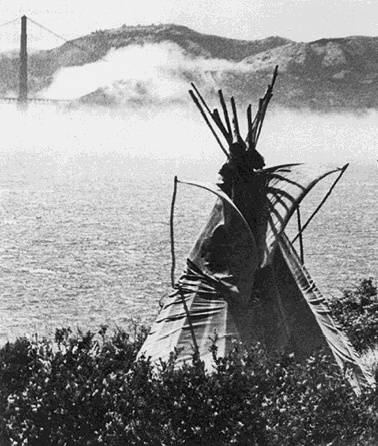The Indian Occupation of ALCATRAZ: Difference between revisions
m (1 revision(s)) |
No edit summary |
||
| Line 1: | Line 1: | ||
[[Image:nativam$alcatraz-teepee.jpg]] | [[Image:nativam$alcatraz-teepee.jpg]] | ||
A "Teepee" on Alcatraz during the occupation (1969-1971) | '''A "Teepee" on Alcatraz during the occupation (1969-1971)''' | ||
''Photo: © by Ilka Hartmann'' | |||
The occupation had a galvanizing effect on Indians throughout the Bay Area, and ultimately the entire country. Reversing the historic precedent in Manhattan, the Alcatraz warriors offered $24 in beads for the island. The U.S. government, already besieged by urban riots across the land, violent anti-Vietnam War protests, and the exploding social movements that are remembered collectively as the "sixties," imposed a Coast Guard blockade around Alcatraz. A big effort to communicate the Indians' position to the media led to initially sympathetic coverage, and with that help the Alcatraz occupiers received a tremendous outpouring of public support. A number of boaters were willing to run the blockade, and within a few days the government rescinded it. | The occupation had a galvanizing effect on Indians throughout the Bay Area, and ultimately the entire country. Reversing the historic precedent in Manhattan, the Alcatraz warriors offered $24 in beads for the island. The U.S. government, already besieged by urban riots across the land, violent anti-Vietnam War protests, and the exploding social movements that are remembered collectively as the "sixties," imposed a Coast Guard blockade around Alcatraz. A big effort to communicate the Indians' position to the media led to initially sympathetic coverage, and with that help the Alcatraz occupiers received a tremendous outpouring of public support. A number of boaters were willing to run the blockade, and within a few days the government rescinded it. | ||
| Line 11: | Line 13: | ||
A full year later, July 11, 1971, the Indians had been comfortably living on the island for many months, and only fifteen Indians were there when federal marshals and the Coast Guard arrived to clear Alcatraz of its occupiers. They offered no resistance, and after their removal the U.S. government stationed a contingent of troops to prevent further invasions. A couple of years later Alcatraz became part of Phil Burton's Golden Gate National Recreation Area, and to this day it is a very popular visit for tourists and locals alike. | A full year later, July 11, 1971, the Indians had been comfortably living on the island for many months, and only fifteen Indians were there when federal marshals and the Coast Guard arrived to clear Alcatraz of its occupiers. They offered no resistance, and after their removal the U.S. government stationed a contingent of troops to prevent further invasions. A couple of years later Alcatraz became part of Phil Burton's Golden Gate National Recreation Area, and to this day it is a very popular visit for tourists and locals alike. | ||
''--based on ALCATRAZ! ALCATRAZ!'' | |||
''--Adam Fortunate Eagle, [http://www.heydaybooks.com/ Heyday Books]: Berkeley, CA © 1992 | |||
[[FROM ARIZONA TO ALCATRAZ: Hopi prisoners on Alcatraz |Prev. Document]] [[ALCATRAZ Proclamation |Next Document]] | |||
[[ | [[category:Indigenous]] [[category:1960s]] [[category:1970s]] [[category:Dissent]] | ||
Revision as of 23:02, 4 October 2008
A "Teepee" on Alcatraz during the occupation (1969-1971)
Photo: © by Ilka Hartmann
The occupation had a galvanizing effect on Indians throughout the Bay Area, and ultimately the entire country. Reversing the historic precedent in Manhattan, the Alcatraz warriors offered $24 in beads for the island. The U.S. government, already besieged by urban riots across the land, violent anti-Vietnam War protests, and the exploding social movements that are remembered collectively as the "sixties," imposed a Coast Guard blockade around Alcatraz. A big effort to communicate the Indians' position to the media led to initially sympathetic coverage, and with that help the Alcatraz occupiers received a tremendous outpouring of public support. A number of boaters were willing to run the blockade, and within a few days the government rescinded it.
The Indians on the island did their best to make it livable, although the absence of running water kept them dependent on the mainland support movement. A water barge holding 250,000 gallons maintained their supplies until the Coast Guard towed it away on May 9, 1970. Not long after, the government cut off the electricity to the island, shutting down the lighthouse and foghorn, much to consternation of many San Franciscans.
After the water barge had been gone a few weeks, a terrible fire broke out on June 1, 1970 in two locations at once. It was never determined how these fires started, with both occupiers and government blaming each other, but it led to worse damage than that caused by the biggest prison riot in Alcatraz's history in 1946. Chronicle editor Scott Newhall, whose apartment overlooked the bay, paid to have the lighthouse and foghorn fixed.
A full year later, July 11, 1971, the Indians had been comfortably living on the island for many months, and only fifteen Indians were there when federal marshals and the Coast Guard arrived to clear Alcatraz of its occupiers. They offered no resistance, and after their removal the U.S. government stationed a contingent of troops to prevent further invasions. A couple of years later Alcatraz became part of Phil Burton's Golden Gate National Recreation Area, and to this day it is a very popular visit for tourists and locals alike.
--based on ALCATRAZ! ALCATRAZ!
--Adam Fortunate Eagle, Heyday Books: Berkeley, CA © 1992

